Home
Emergency Numbers
Annual Reports
Bike Registration
Chief of Police Message
Citizen Survey
City Ordinances
Complaints
Contact Us
Crime Alert
Crime Prevention Tips
FAQ’s
History
Links
Map of the City
Meet Your Officers
Missing Persons
Mission and Values
Newsletters
Parking Regulations
Photo
Gallery
Press Releases
Public Records Request
Recruitment Program
Speed Watch Program
Success Stories
Vacation House Checks
|
|
School Bus
Safety Last
updated 2/18/2008
| |
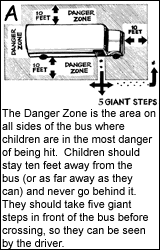 |
 |
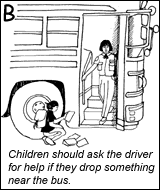 |
 |
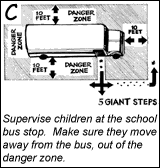 |
 |
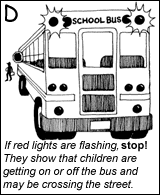 |
 |
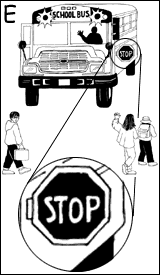 |
| The
extended stop signal arm alets
traffic when children get on
or off the bus. |
|
 |
School
bus stops:
a risky part of the ride
Why students are in
danger
Millions of children in the United
States ride safely to and from school
on school buses each day. Although
school buses are the safest way to get
them to school, an average of 33
school-age children die in school
bus-related traffic crashes each year.
Most of those killed are
pedestrians, five to seven years old.
They are hit in the danger zone around
the bus (A), either by a
passing vehicle or by the school bus
itself. It is illegal for a car to
pass a bus with its red light flashing
(see other side).
Young children are most likely to
be hit because they: hurry to get on
or off the bus, act before they think
and have little experience with
traffic, assume motorists will see
them and will wait for them to cross,
don't always stay within the bus
driver's sight.
Safety steps you can
take
- Supervise children to make sure
they get to the stop on time, wait
far away from the road, and avoid
rough play.
- Teach your child to ask the
driver for help if he drops
something near the bus (B).
If a child stoops to pick up
something, the driver cannot see
him. Then he could be hit by the
bus. A book bag or backpack helps
keep loose items together.
- Make sure clothing has no loose
drawstrings and backpack straps
are short, so they don't get
caught in the handrail or bus
door.
- Encourage safe school bus
loading and unloading (see below).
- If you think a bus stop is in a
dangerous place, talk with your
school office or transportation
director about changing the
location.
Teach your child
to get on and off the bus safely
1. When loading, stay away from
the danger zone and wait for the
driver's signal. Board the bus in
single file.
2. When unloading, look before
stepping off the bus to be sure no
cars are passing on the shoulder
(side of the road). Move away from
the bus (C).
3. Before crossing the street,
take five "giant steps"
out from the front of the bus, or
until the driver's face can be
seen. Wait for the driver to
signal that it's safe to cross.
4. Look left-right-left when
coming to the edge of the bus to
make sure traffic is stopped.
Continue to watch for traffic when
crossing.
Risky business
for motorists:
Passing a stopped school bus
What is the most dangerous part
of the school bus ride? The bus
stop!
Children are at greatest risk
when they are getting on or off
the school bus. Most of the
children killed in bus-related
crashes are pedestrians, five to
seven years old, who are getting
on or off the bus. They are hit by
the school bus or by motorists
illegally passing a stopped bus.
In neighborhoods, near schools,
and at bus stops, drivers need to
take special care because children
do not behave like adults.
Elementary school children:
- Become easily distracted and may
start across the street without
warning
- Don't understand the danger of
moving vehicles
- Can’t judge vehicle speed or
distance
- May be blocked from view by the
bus
Most importantly, children
expect vehicles to stop for them
at the school bus stop.
Standard school
bus stop laws
Learn and follow the school bus
laws for motorists in your state.
Laws exist to protect children
getting on and off the bus AND to
protect you from a tragedy. Check
with your school transportation
office or police department for
more information on your state's
laws. Here are standard rules:
- Motorists coming to a school bus
from either direction must stop
when the bus displays flashing red
warning lights and extends the
stop signal arm (D and E). These
signals show that children are
getting on or off the school bus.
- Vehicles may not pass until the
flashing red lights and signals
are turned off.
- Drivers traveling in the same
direction as the bus are always
required to stop.
- In some states, drivers moving
in the opposite direction on a
divided roadway are also required
to stop. Check the law in your
state.
- Never pass on the right side of
the bus, where children enter or
exit. This is illegal and can have
tragic results.
Violation of these laws can
result in a citation and fine. In
many places, school bus drivers
can report passing vehicles!
For
more information, call the
NHTSA Auto Safety Hotline:
1-888-DASH-2-DOT
or visit the NHTSA website,
www.nhtsa.dot.gov.
|
|
 |
 |
|
|
|